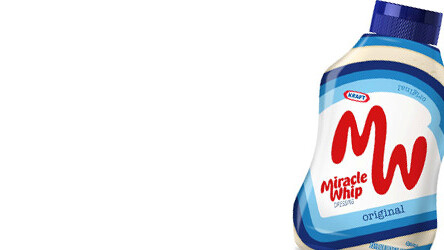
Love us, or hate us? That’s the message that Kraft Food’s Miracle Whip has been asking consumers since the “Are you Miracle Whip?” campaign launched this past February. Initially debuted during a commercial break from “American Idol,” the Miracle Whip campaign features a wide variety of celebs giving a thumbs up/thumbs down reaction to the mayonnaise-esque condiment, and encouraging others to do the same via social media channels, primarily YouTube, Facebook and Twitter.
Major network television spots with social media tie-ins aren’t the newest offering on the block, however the method in which Kraft is choosing to leverage them is. As we’ve seen with Facebook, especially for marketers, interaction is key. You might remember a small suggestion I made in my Facebook EdgeRank article about throwing out political based thoughts, and watch the comments come rolling in? Well, I’m not going to say that McGarryBowen and AKQA have been reading my article exclusively, but they’ve obviously keyed in on the polarization factor, especially when it comes to Miracle Whip.
YouTube
Perhaps realizing that any polarizing issues will eventually lead to naysayers, on both sides of the fence, Kraft wisely offers up both pro and con points of view in the television ads and supporting YouTube campaign. Political commentator James Carville says that, “Miracle Whip is America,” and Amy Sedaris offers up, “it’s always great in the bedroom.” While Jersey Shore’s Pauly D doesn’t quite see it that way, “I’d never eat it, I’d never put it in my hair. It’s just wrong.”
And it’s precisely this division that Kraft is banking on. Love it or hate it, if you’ve tasted Miracle Whip, chances are you have an opinion. No opinion? Oh, you’re just what the doctor ordered! The overall goal and driver of the campaign is to do just that; provide consumers with a sample of the product and allow them to make up their own informed opinion – good or bad. Links to the free sample are predominantly placed, ensuring that users get the message: Make up your own mind.
While there doesn’t appear to be a strong comments posting link between the Miracle Whip YouTube channel and Facebook account, upon visiting the Miracle Whip Facebook page, users are greeted with a Love or Hate? page soliciting opinions on the core message in 70 characters or less with a simple mechanism then inserts these positive comments into the Miracle Whip wall. Not missing a beat in the market research department, those with negative feelings towards the brand can have their say, but obviously, these comments are not inserted into the Facebook wall. As one could imagine, the Miracle Whip Facebook wall now reads like a marketer’s dream “Testimonials” playbook.
By engaging both sides of the fence, Kraft is upping their EdgeRank score here by actively asking users to submit feedback. By interacting with the brand, users are creating a stronger affinity score towards Miracle Whip, a powerful tool for future marketing efforts.
And what would a social media campaign be without a healthy dose of Twitter? The standard campaign could have taken the route of “Love or Hate?”, but in all reality, just how far can you stretch three words, over and over again? To combat the repetition process, Kraft has jumped onboard with some of those appearing in the television spot. The prime example would be taking the words right out of Pauly D’s mouth and running with it. As the excerpt below shows, Pauly’s not a fan, “If I had a girlfriend who liked Miracle Whip, it’s a dealbreaker.” Miracle Whip took the critique and managed to turn the phrase around and ask users what they considered to be a “dealbreaker.” Completely non-brand related, but a great buzz generator, ultimately resulting in … well people like me writing about it, and interested folks like you reading about it.
Here we have a great campaign underway by a brand that’s embracing the simple fact that their product is either beloved or dreaded. By structuring the campaign in a highly interactive way, Kraft/Miracle Whip have set themselves up for a win/win situation. If, the “Haters” outweigh the “Lovers,” Kraft would be in a unique position to, yet again, turn the table and ask the Haters if they’d recently tried the ‘Whip.
To date, the YouTube counter places 51,478 “Lovers” in Miracle Whip’s corner, while 2,985 “Haters” … are also in Miracle Whip’s corner.
The ultimate goal of this campaign is not to sway “Haters” over to the “Lovers” side, but again, provide consumers with the option to make an educated choice – and for free. And let’s face it, we all know the taste of Ketchup. We all know the taste of mustard. But do we all know the taste of Miracle Whip? If Kraft, McGarryBowen, and AKQA have anything to say about it, we’ll all be Lovers or Haters soon enough.
And just for the record … hold the mayo and the Miracle Whip on my sandwiches, if you please.
Get the TNW newsletter
Get the most important tech news in your inbox each week.
